Serviços Personalizados
Journal
Artigo
Indicadores
-
 Citado por SciELO
Citado por SciELO -
 Acessos
Acessos
Links relacionados
-
 Similares em
SciELO
Similares em
SciELO
Compartilhar
Ciência e Técnica Vitivinícola
versão impressa ISSN 0254-0223
Ciência Téc. Vitiv. vol.27 no.2 Dois Portos dez. 2012
Effect of irrigation on soil water depletion, vegetative growth, yield and berry composition of the grapevine variety Touriga Nacional
Efeito da rega na depleção da água no solo, crescimento vegetativo, rendimento e composição da uva da casta Touriga Nacional
João Gouveia1*; Carlos M. Lopes2; Vanda Pedroso3; Sérgio Martins3; Pedro Rodrigues1;Isabel Alves2
1Escola Superior Agrária de Viseu, Instituto Politécnico de Viseu, Quinta da Alagoa, Ranhados, 3500-606 VISEU, Portugal.
2CBAA, Instituto Superior de Agronomia/Universidade Técnica de Lisboa, Tapada da Ajuda, 1349-017 LISBOA, Portugal.
3DRAPC/ Centro de Estudos Vitivinícolas do Dão, Quinta da Cale, 3520-090 NELAS, Portugal.
*Corresponding author:
SUMMARY
Aiming to assess the effects of irrigation amount on vegetative growth, yield and berry composition of the red variety Touriga Nacional (Vitis vinifera L.) a field trial was installed at the Centro de Estudos Vitivinícolas do Dão, Nelas, Portugal. The effects of three irrigation treatments (DI30 - 30% of ETc; DI50 - 50% ETc and FI - 100% ETc) were compared to a control non-irrigated (NI) during three growing seasons (2006-2008). Irrigation affected significantly the fraction of available soil water and the pattern of soil water extraction by the roots either in the row and interrow. Predawn leaf water potential was also influenced by irrigation amount being the main differences observed between FI (highest values) and NI (lowest values). Compared to NI, the full irrigation treatment (FI) induced a significantly higher vigour while the deficit irrigation treatments (DI30 & DI50) returned intermediate values. The FI treatment induced a significantly higher yield as compared to the other treatments which returned similar values. Compared to the control non-irrigated, the deficit irrigation treatments presented similar berry composition during all the three seasons while the FI treatment showed a significantly higher total acidity, lower total soluble solids and anthocyanins concentration. With the exception of the higher yield observed in FI treatment, in these three seasons irrigation had no other agronomical advantages enabling us to conclude that, in the ecological and viticultural conditions of the experiment, irrigation seems not to be necessary. However, further studies are needed mainly in soils with lower water holding capacity and in dryer years which frequency are expected to increase in the near future as a consequence of the climate change.
Key words: berry composition, irrigation, vigor, yield, Touriga Nacional.
RESUMO
Com o objectivo de estudar a influência da rega no crescimento vegetativo, rendimento e composição da uva da casta Touriga Nacional foi instalado um ensaio numa vinha do Centro de Estudos Vitivinícolas do Dão, Nelas, Portugal. Compararam-se os efeitos de três modalidades de rega (DI30 - 30% ETc; DI50 - 50% ETc e FI - 100% ETc) com uma testemunha não regada (NI) durante três anos consecutivos (2006 a 2008.). A rega influenciou de forma significativa quer a fracção de água disponível no solo quer o seu padrão de extracção na linha e entrelinha. O potencial hídrico foliar de base também foi influenciado pela rega tendo-se observado as maiores diferenças entre a modalidade FI (maiores valores) e a modalidade NI (menores valores). A modalidade FI apresentou um maior vigor quando comparada com a modalidade não regada enquanto as modalidades de rega deficitária (DI30 & DI50) apresentaram valores intermédios. Quando comparadas com a testemunha não regada, as modalidades de rega deficitária não apresentaram diferenças significativas quer no rendimento quer na composição das uvas à vindima. A modalidade FI conduziu à obtenção de um maior rendimento e de mostos com acidez total mais elevada e teores em açúcar e antocianinas mais baixos que as restantes modalidades. Com excepção do maior rendimento obtido na modalidade FI, nestes três anos de ensaio a rega não proporcionou outras vantagens agronómicas pelo que podemos concluir que, nas condições ecológicas e vitícolas do ensaio, a rega parece ser uma técnica cultural desnecessária. No entanto são necessários mais estudos, sobretudo em solos com menor capacidade de retenção de água e em anos mais secos, cuja frequência se prevê que venha a aumentar no futuro próximo em consequência das alterações climáticas.
Palavras-chave: composição do bago, rega, vigor, rendimento, Touriga Nacional.
INTRODUCTION
Water stress and supra-optimal temperatures are known to decrease plant carbon assimilation (Maroco et al., 2002; Chaves et al., 2007), to reduce vegetative growth and yield and to affect berry composition (Esteban et al., 1999; Ojeda et al., 2002; Santos et al., 2003, 2005; Pellegrino et al. 2005). In dry viticultural regions deficit irrigation strategies have been successfully adopted as management tools to ensure an adequate balance between vegetative and reproductive development whereas preserving yield and improving fruit composition (Stoll et al., 2000; Dry et al., 2001; Santos et al., 2003; Loveys et al., 2004; Roby et al., 2004). However, the irrigation amount should be adjusted to the terroir and type of wine to be produced in order to avoid potential negative impacts on vine vigour, berry composition and wine quality. When applied in excess, irrigation might induce an excessive vegetative growth, increase berry size and reduce skin anthocyanins and polyphenol concentrations and, consequently, have a detrimental impact on wine quality (Williams and Mattews, 1990; Esteban et al., 2001; Santos et al., 2003, 2005, Intrigliolo and Castel, 2011).
In most part of Portugal grapevine has been cultivated traditionally without irrigation but in recent years there have been a strong increase in the irrigated area because the growers are afraid of the negative impacts of water deficits on vigor, yield and quality which frequency have increased in recent years (Lopes et al., 2001; Chaves et al., 2007). This problem affects mainly areas where low water holding capacity soils are combined with high evaporative demand and with low summer rainfall, as is the case of some vineyards at the Dão winegrowing region in Portugal (Pedroso et al., 2012). On the other hand, the predictions about global warming in the near future suggest a reduction in rainfall in southern Europe and an increased evapotranspiration (IPCC, 2007). The achievement of these scenarios will lead to more frequent water stress situations with the consequent negative impacts on the viticulture of Mediterranean winegrowing areas.
The Dão winegrowing region is located in the Center-North of Portugal and presents a mesothermic climate, with a warm and dry summer and a cold and rainy winter (Loureiro and Cardoso, 1993). Despite the high yearly average rainfall (1100 mm) only a small fraction (8%) falls during the summer. As most part of the soils are granitic derived with low water holding capacity, in dry years it is common to observe water stress symptoms mainly during the ripening period. The frequency of those water stress situations have increased in the last decade (Pedroso et al., 2012) and, consequently, some growers are now asking the extension services for more information about the feasibility of using irrigation on their traditionally rain fed vineyards.
Touriga Nacional (TN) is a Portuguese native red variety widely grown in many Portuguese winegrowing regions, namely the Douro and Dão. It is a vigorous variety but, when submitted to water stress it reacts by an early senescence of basal leaves, problem that increases when the water stress is combined with heat stress. In such circumstances, depending on the stage of ripening, the resulting increase in cluster exposure can cause berry sunburn and negative effects on yield and berry composition like, for example, a reduction in acidity and aromas (Marais et al., 1999; Winter, 2002; 2009). Moreover, in regions with hot and dry summers, like the case of the Dão winegrowing region, the high temperature that the exposed berries can reach may also negatively affect the anthocyanins content either by inhibiting the synthesis and/or by promoting their degradation or, more common, for both reasons (Kliewer and Torres, 1972, Haselgrove et al., 2000; Spayd et al. , 2002).
Recognized by its high quality, the plantations of TN increased in recent years in all Portugal and abroad (from 422 hectares in 1983 to 1300 hectares in 2008; CVRDão, 2008), however, to our knowledge, only a few studies have been done to understand how water availability influence TN vegetative growth, grape composition and wine quality (Rodrigues, 2011; Costa et al., 2012; Lopes et al., 2012). This work aims to assess the effects of different water regimes on soil water depletion, vegetative growth, yield and berry composition of the red variety 'Touriga Nacional' at the Dão winegrowing region during a three year period (2006-2008).
MATERIAL AND METHODS
Site and plant material
This work took place at the Dão Grape and Wine Research Station (Centro de Estudos Vitivinícolas do Dão – CEVDão), Quinta da Cale, Nelas (Latitude 40° 31'N, Longitude 7° 51'W, Elevation 440 m) in a vineyard planted in 2000 with the red grape variety 'Touriga Nacional' grafted on 110 R rootstock. The vines were spaced 1.1 m within and 2.0 m between rows, trained on a vertical shoot positioning with a pair of movable wires and spur-pruned on a bilateral Royat Cordon system. All vines were uniformly pruned to 11 nodes per vine and during spring a shoot thinning was applied in order to adjust the shoot number to the average crop load.
Experimental design and irrigation management
The experimental design was a randomized complete block design with four replications of twelve vines per elemental plot, and the following four treatments: NI - Non irrigated (rainfed, control); DI30 - deficit irrigation of 30% crop evapotranspiration under standard conditions (ETc); DI50 - deficit irrigation of 50% ETc and FI (full irrigation) - 100% ETc. Two buffer rows were established at the borders of the experiment and each elemental plot was separated by buffer vines (2 to 6 vines).
The soil is from granitic origin, with a coarse texture (56,5 % course sand; 19,5 fine sand; 20 % silt and 4% clay), and a very good infiltration capacity, a pH in water of 5.8, 1.4% of organic matter, 108 mg/kg of phosphorus and 92 mg/kg of potassium. Meteorological variables (net and solar radiation, temperature, rainfall, wind speed and relative humidity) were measured at an automatic weather station installed within the experimental plot. Reference evapotranspiration (ETo) was determined using the FAO-PM equation (Allen et al., 1998).
Drip irrigation lines were positioned along the row close to the vine trunks and consisted of self-compensating and self-cleaning 1.7 L/h drippers spaced 0.75 m. Irrigation scheduling was based on the available soil water, expressed as a percentage of transpirable soil water down to the 0.6 m depth (FTSW0-60). In full irrigation plots (FI), in order to achieve 100% ETc, irrigation events were scheduled whenever FTSW0-60 reached values between 40 and 50 %. In the deficit irrigation treatments (DI30 and DI50) the critical FTSW0-60 levels were 10 to 20% and 20 to 30%, respectively for DI30 and DI50. Irrigation depth was calculated from the accumulated values of daily ETc, as determined with the methodology of Allen et al. (1998), and rainfall occurred since the last irrigation event. Table I presents the first and last irrigation dates and total amount of water applied.
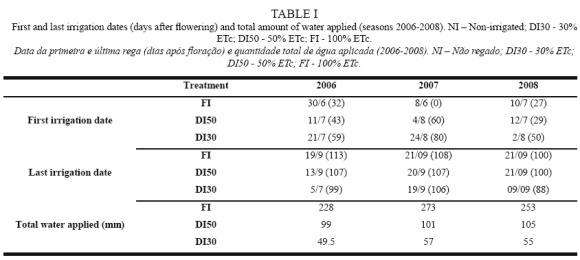
Measurements
Soil water content was measured with a portable capacitance probe (Diviner 2000®; Sentek Sensor Technologies, South Australia), calibrated for the soils of this experiment. In each elemental plot two access tubes were installed, one in the row, between two contiguous vines and close (0.05 m) to the dripper, and the other in the middle of the interrow. Readings were taken twice a week between budburst and harvest at increments of 0.1 m from the soil surface to a depth of 1.6 m. At a given date the available soil water (ASW) was calculated as the difference between soil water content on the day of measurements and the minimum soil water content, calculated with volumetric water content at wilting point (~ pF 4.2).
The fraction of available soil water (FASW) was calculated as the ratio of ASW to total transpirable soil water according to Rodrigues et al. (2012).
Vine predawn leaf water potential (ψpd) was periodically measured between flowering (beginning of June) and harvest (last week of September). Measurements were carried out on an adult leaf from twelve replicate plants of each treatment (3 leaves per elemental plot), using a pressure chamber (Model 600 PMS instrument Co., Corvallis, OR, USA).
Canopy density at the fruit zone was assessed by point quadrat analysis (Smart and Robinson, 1991) and, in winter, shoot number and fresh pruning weight per vine were recorded. The yield was monitored by recording the number of clusters and their total weight from the 12 plants per elemental plot. At harvest a sample of 100 berries per elemental plot was collected and the juice was analyzed for soluble solids, titratable acidity, pH and total phenols by Fourier Transform Infrared Spectroscopy (FTIR). Berry skin anthocyanins were determined by the method of discoloration by sodium bisulfite and total phenols by Folin-Ciocalteau index (Ribéreau-Gayon et al., 1972).
Data analysis
Data was subjected to a two-way analysis of variance using the SAS® program package (SAS Institute, Cary, NC, USA). Year was considered as a random variable and the error term for the treatment factor was the year × treatment interaction mean square (Gomez and Gomez, 1984). Treatment comparison was performed each year by LSD test at P ≤ 0.05.
RESULTS AND DISCUSSION
Climate
During the experimental period (2006–2008) the mean air temperature ranged between 5ºC (mean minimum monthly temperature in January 2006) and 23ºC (mean maximum monthly temperature in August 2006), being 2006 the season with the hottest growing period. The total annual rainfall was 900, 1390 and 713 mm, in 2005/2006, 2006/2007 and 2007/2008 hydrological years, respectively, being 2006/2007 the wettest one (Fig. 1).
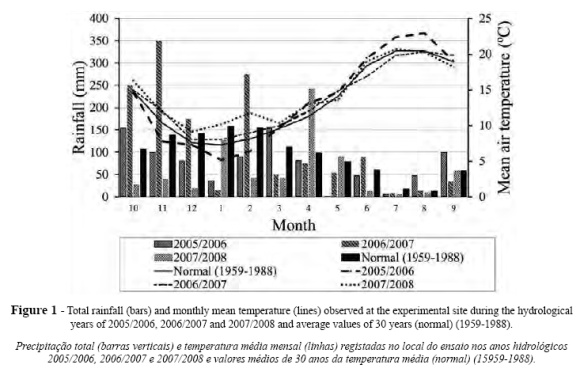
Soil and plant water status
During the experimental period the seasonal pattern of volumetric soil moisture in the 0–1.6 m soil profile showed a similar decreasing trend throughout the growing season in all treatments and seasons (data not shown). The FTSW0-160 during the 2007 season showed a decreasing pattern in all treatments during the period between budburst and flowering and then a small recover in the beginning of July caused by the rainfall (Fig. 2). After that rainfall, while in the NI treatment, the FTSW0-160 showed a decreasing trend, achieving the lowest values at the end of August, in the irrigated treatments it presented an oscillatory pattern induced by the irrigation events. At the end of the season the FTSW0-160 presented a recover induced by the rainfall occurred in the middle of September.
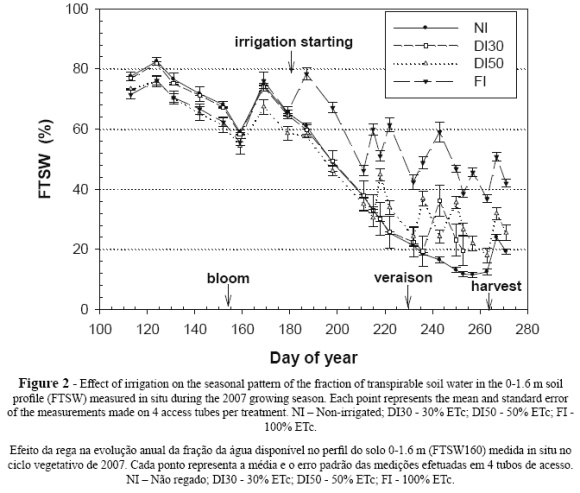
Soil water depletion (SWD) in the 1.6 m profile was calculated either for the row and interrrow assuming the absence of runoff, deep percolation and capillary rise from deeper layers. Despite some differences observed in the behavior of SWD the general trend was similar for the three seasons (data not shown). Fig. 3 presents the daily average SWD calculated for three main growing periods of the 2007 season. During the spring SWD presented similar values in the row and in the interrow but from flowering to harvest the SWD in the row was, in general, higher than that of the interrow. During the spring period (April 23th to June 8th) all treatments presented similar SWD both in the row and interrow (ca.1 mm.day-1) indicating that, in the absence of irrigation, the vines explore in a similar way both the row and the interrow as observed by other authors (Stevens and Douglas, 1994; Rodrigues, 2011). Within the period flowering-veraison the FI treatment presented a different SWD than that of the other treatments which showed statistically similar values. While in therow FI presented the significantly highest SWD value (2.2 mm.day-1), in the interrow it showed the lowest one (1.2 mm.day-1). During the ripening period, the SWD of the irrigation treatments increased with the increase of the irrigation amount (Fig. 3) and the two deficit irrigation treatments showed statistically similar SWD values but higher than the control non-irrigated. During that period the SWD of the irrigation treatments presented an increase in the row and a decrease in the interrow. This differential behavior between row (wet) and interrow (dry) zones can be explained by the effect of irrigation on the pattern of soil water extraction by the roots in the wetted zone. Indeed, in drip irrigation vineyards it is common to observe an increase of water extraction from the top soil wetted layers near the drippers and a decrease both in the interrow and at deeper layers (Stevens and Douglas, 1994; Rodrigues, 2011). In the whole monitored period (158 days in 2007), the total row SWD in FI was almost the double (2.2 mm.day-1) of that of NI (1.2 mm.day-1-1) while the deficit irrigated treatments presented intermediate values (1.5 mm.day-1 and 1.9 mm.day-1 in the DI30 and DI50 respectively). In the interrow FI was the treatment with the lowest SWD.
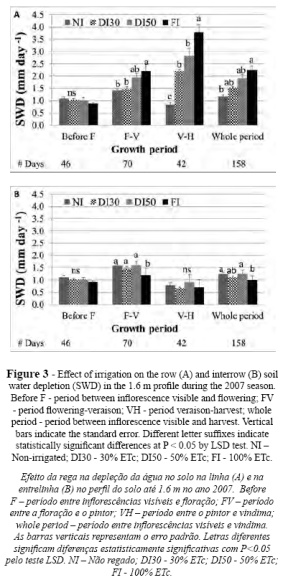
Predawn leaf water potential
As compared to 2007 and 2008 the first season of the experiment (2006) was the driest one as can be observed from the predawn leaf water potential (ψpd) values presented by the NI treatment (Fig. 4). Indeed, after the 2006 flowering in the non-irrigated vines the ψpd displayed a decreasing pattern attaining the lowest values at the end of August (ca -0.4 MPa) which indicates a moderate water stress situation (Deloire et al., 2003). In 2006 irrigation affected significantly the predawn values in most part of the measurements being the main differences observed between FI (highest values) and NI (lowest values) while the deficit irrigation treatments presented intermediate values which were close to FI (DI50) or to NI (DI30). These differences can be explained by the effect of irrigation on soil water availability as ψpd equilibrates with soil water potential of the more wetted soil volume explored by the roots (Pacheco, 1989; Jones and Tardieu, 1998, Lopes et al., 1999).
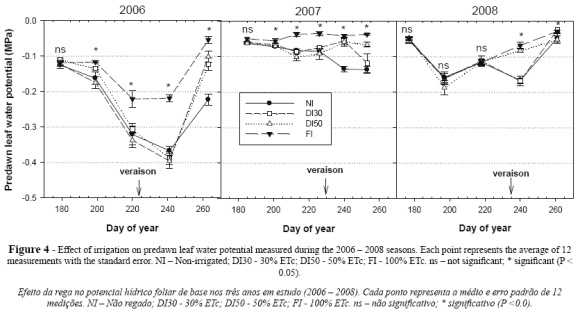
In the 2007 and 2008 seasons all treatments showed ψpd values higher than -0.20 MPa during all season indicating the absence of water stress (Van Leeuwen et al., 2009) and, despite some significantly higher values presented by FI ( mainly in 2007), in general, the differences between treatments had a very low magnitude.
Vegetative growth, yield and berry composition
Shoot number per vine presented similar values along the three seasons with no significant effect of the irrigation amount (Table II). The absence of differences may be explained by the adjustments made to the shoot number by the shoot thinning done in spring on all treatments. The average winter pruning weight presented an increase from 2006 to 2008 (0.6, 0.9 and 1.2 kg per vine for 2006, 2007 and 2008 respectively). The higher pruning weight observed in 2008 could be attributed to the lower competition of the reproductive sink caused by the poor setting observed in that season. Compared to NI the FI treatment induced a significantly higher winter pruning weight while the deficit irrigation treatments returned intermediate values (Table II). As for the pruning weight, the average shoot weight, one of the best indicators of vine vigour (Champagnol, 1984), showed an increase from 2006 to 2008 (46.5, 69.5 and 105.0 g per shoot respectively). This vigour increase may be explained by the differences observed between seasons on the weather conditions and/or on the fruit to shoot ratio as 2008 had a very low yield. The effect of irrigation amount on shoot weight mirrored that reported for pruning weight. This increase in vegetative growth in the FI treatment as compared to NI is a common result observed in irrigation experiments (Kliewer et al., 1983; Williams, 2000; Santos et al., 2003; De la Fuente et al., 2007) being explained by the positive effect of the higher available water on vegetative growth (Williams and Matthews, 1990).
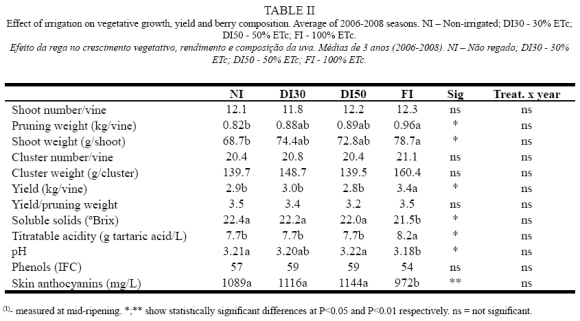
The cluster number presented similar values along the three seasons and was not significantly affected by the irrigation treatments (Table II). The average yield was similar in 2006 and 2007 (3.7 and 4.0 kg/vine respectively) but was very low in 2008 (1.5 kg/vine) as a consequence of a poor setting, which induced a strong reduction of the cluster weight (from 179.2 and 191.5 g/cluster, in 2006 and 2007 respectively to 70.5 g/cluster in 2008). This poor setting observed in 2008 was induced by the lower temperatures and rainfall occurred during the flowering period (May, 2004) and is a common problem for this variety which is very prone to coulure (Brites and Pedroso, 2000). Regarding the effect of irrigation, due to a higher cluster weight, the FI treatment presented a significantly higher yield than the other treatments which returned statistically similar values. A similar irrigation effect was obtained by Santos et al., (2003; 2005) with the red variety Castelão in Portugal and by Intrigliolo and Castel (2008) in Spain with the variety Tempranillo.
Regarding berry composition, in average the full irrigation treatment induced a significantly lower Brix, higher titratable acidity and lower pH as compared to the other two deficit irrigation treatments which presented statistically similar values to the non-irrigated one. This effect was much more pronounced in 2007 and 2008 than in 2006. The better plant water status combined with the higher canopy density in the FI treatment relative to the other treatments (data not shown: e.g. 2007: leaf layer number at mid-ripening was 2.25, 2.7, 2.67 and 3.21, respectively in NI, DI30, DI50 and FI treatments), could explain the higher must titratable acidity of FI treatment as must acidity was shown to decline with water and heat stress due to an accelerated decrease in malic acid (Esteban et al., l999; Williams and Matthews, 1990).
No significant differences were detected in total phenols, but the FI treatment presented a significantly lower berry skin anthocyanins concentration than the other treatments which returned similar values (Table II). This lower berry skin anthocyanins observed in the FI treatment is a common result reported in most part of the irrigation experiments that compares a full irrigation treatment with deficit irrigation and/or non-irrigated grapevines (e.g. Santos et al., 2005; Ojeda, 2008). The possible explanations for these effects are related to the, already reported, effect of the higher plant water availability on the promotion of vegetative and reproductive growth and the consequent negative impacts either on the cluster zone microclimate and/or the skin/pulp ratio (Williams and Mathews 1990; McCarthy et al., 2002; Roby et al, 2004; Santos et al., 2005).
CONCLUSIONS
Despite the fact that in the non-irrigated vineyards of the Dão winegrowing region it is very common to observe vine water stress symptoms, mainly at the ripening period (Pacheco et al., 1997; Andrade, 2003), during the three studied seasons (2006-2008), only in 2006 we were able to detect a moderate water stress situation. Soil water depletion curves show that in the absence of irrigation the vines explore in a similar way both the row and the interrow but when irrigated they reduce the extraction of water from the interrow. The full irrigation treatment produced a higher yield but induced an excessive vine vigour and lower must quality. Besides the differences in the amount of water applied, both deficit irrigation treatments showed similar vine responses on vigour, yield and berry composition which were not statistically different from the control non-irrigated.
As in the three studied seasons, irrigation had no major agronomical advantages relatively to the control non-irrigated we can conclude that, in this terroir, irrigation seems not to be necessary. However, this conclusion should be looked with care because the two last seasons of the experiment were characterized by abnormally low atmospheric demand during the summer, which is atypical for this region of hot and dry summers. Further studies are needed mainly in soils with lower available water than the one of our experiment and in dry years which frequency are expected to increase in the near future as a consequence of the climate change.
ACKNOWLEDGEMENTS
We thank the Fundação para a Ciência e Tecnologia (FCT) through the Project POCTI/AGG/38506/2001 and the Polytechnic Institute of Viseu for the partial support given for this study.
REFERENCES
Allen R.G., Pereira L.S., Raes D., Smith M., 1998. Crop evapotranspiration. Guidelines for computing crop water requirements. FAO Irrigation and Drainage Paper 56. FAO, Roma. [ Links ]
Andrade, I. 2003. Efeito da intensidade da desfolha da videira (Vitis vinifera L.) na fotossíntese, na produção e na qualidade. Dissertação de Doutoramento. Instituto Superior de Agronomia da Universidade Técnica de Lisboa. [ Links ]
Brites J., Pedroso V., 2000. Castas Recomendadas da Região do Dão. 24 p. Direcção Regional de Agricultura da Beira Litoral (ed.), Nelas, Portugal. [ Links ]
Champagnol F., 1984. Eléments de physiologie de la vigne et de viticulture générale. Ed. Auter, Montpellier. [ Links ]
Chaves M.M., Santos T.P., Souza C.R., Ortuño M.F., Rodrigues M.L., Lopes C.M., Maroco J.P., Pereira J.S., 2007. Deficit irrigation in grapevine improves water-use efficiency while controlling vigour and production quality. Ann. Appl. Biol., 150, 237-252. [ Links ]
Costa J.M., Ortuño M.F., Lopes C.M., Chaves M.M., 2012. Grapevine varieties exhibiting differences in stomatal response to water deficit. Funct. Plant Biol., 39, 179-189. [ Links ]
CVRDão, 2008. Relatório da situação actual do património Vitícola da Região do Dão. Comissão Vitivinícola Regional do Dão, Viseu, 2008. [ Links ]
De la Fuente M., Jiménez L., Sebastian B., Hernández M., Baeza P., 2007. Efecto de Diferentes Dosis e Frequências de Riego Sobre el Estado Hídrico, La Productividad y La Composición Del Mosto en Viñedos Cultivados en Suelos Arcillosos. In: Actas do 7º Simpósio de Vitivinicultura do Alentejo, Évora, Vol. 1, 308-316. [ Links ]
Deloire A., Silva P., Martin-Pierrat S., 2003. Terroirs et état hydrique du Grenache noir. Premiers résultats. Prog. Agric. Vitic., 17, 367-373. [ Links ]
Dry P.R., Loveys B.R., McCarthy M.G., Stoll M., 2001. Strategic irrigation management in Australian vineyards.J. Int. Sci. Vigne Vin, 35, 129-139. [ Links ]
Esteban M.A., Villanueva M.J., Lissarrague J.R., 2001. Effect of irrigation on changes in berry composition of Tempranillo during maturation. Sugars, organique acids and mineral elements. Am. J. Enol. Vitic., 50, 418-433. [ Links ]
Esteban M.A., Villanueva M.J., Lissarrague J.R., 1999. Effect of irrigation on changes in the anthocyanins composition of the skyn of cv. Tempranillo (Vitis vinifera L.) grape berries during ripening. J. Sci. Food Agr. 81, 409-420. [ Links ]
Gomez K.A., Gomez A.A., 1984. Statistical procedures for agricultural research. John Wiley and Sons, New York. [ Links ]
Haselgrove L., Botting D., van Heeswijck H.P.B., Dry P.R., Ford C, Iland P.G., 2000. Canopy microclimate and berry composition: the effect of bunch exposure on the phenolic composition of Vitis vinifera L. cv. Shiraz grape berries. Aust. J. Grape Wine Res., 6, 141-149. [ Links ]
Intrigliolo D.S., Castel J.R., 2008. Effects of Irrigation on the Performance of Grapevine cv. Tempranillo in Requena, Spain. Am. J. Enol. Vitic. 59, 30-38. [ Links ]
Intrigliolo D.S., Castel J.R., 2011. Interactive effects of deficit irrigation and shoot cluster thinning on grapevine cv. Tempranillo. Water relations, vine performance and berry and wine composition. Irrig Sci., 29, 443-454. [ Links ]
IPCC, 2007. Climate change: The physical basis summary for policy makers. Cambridge University Press, Cambridge. [ Links ]
Jones, H.G., Tardieu F., 1998. Modeling water relations of horticultural crops: a review. Sci. Hortic., 74, 21-46.
Kliewer W.M., Torres R.E., 1972. Effect of controlled day and night temperatures on grape coloration. Am. J. Enol. Vitic., 23, 71-77. [ Links ]
Kliewer W.M., Freeman B.M., Hossom C., 1983. Effects of irrigation, crop level and potassium fertilization on Carignane vines. I. Degree of water stress and effect on growth and yield. Am. J. Enol. Vitic., 34, 186-196. [ Links ]
Lopes C., Barroso J., Madeira J. Vicente-Paulo J., Cabrita M.J., Rodrigues M.L., Santos T., Chaves M., 2001. Rega da vinha no Alentejo. Dotações e época de aplicação. In: Actas do 5º Simpósio de Vitivinicultura do Alentejo, Évora, Vol. 1, 307-313. [ Links ]
Lopes C.M., Monteiro A., Chaves M., 2012. Comparing water relations and stomatal regulation of Touriga Nacional and Syrah under mild water stress. In: Proc. IX International Terroirs Congress, Dijon and Reims, France, Vol. 1, 33-36. [ Links ]
Lopes, C.M., Vicente-Paulo, J., Pacheco, C., Tavares, S., Barroso, J., Rodrigues, M.L., Chaves, M.M., 1999. Relationships between leaf water potential and photosynthetic activity of field grapevines grown under different soil water regimes. In: Proceedings of the 11th GESCO Meeting, University of Palermo, Sicília, Itália, Vol. 2, 211-217. [ Links ]
Loureiro, V., Cardoso, A.H., 1993. Os vinhos do Dão. Enciclopédia dos vinhos de Portugal. Chaves Ferreira – Publicações, S.A., Lisboa. [ Links ]
Loveys B.R., Stoll M., Davies W.J., 2004. Physiological approaches to enhance water use efficiency in agriculture: exploiting plant signaling in novel irrigation practice. In: Water use efficiency in plant biology. 113-141. Bacon M.A. (Eds.), Univ. Lancaster, Lancaster, UK. [ Links ]
Marais J., Hunter J.J., Haasroek P.D., 1999. Effect of canopy microclimate, season and region on Sauvignon blanc grape composition and wine quality. S. Afr. J. Enol. Vitic., 20, 19-30. [ Links ]
Maroco J.P., Rodrigues M.L., Lopes C.M., Chaves M.M., 2002. Limitations to leaf photosynthesis in field-grown grapevine under drought - metabolic and modelling approaches. Funct. Plant Biol., 29, 451-459. [ Links ]
May P., 2004. Development after fertilization.Flowering and Fruitset in Grapevines. 63-72. May P. (ed.), Lythrum Press Adelaide. [ Links ]
OIV, 1990. Recueil des méthodes internationales d´analyses des vins et des moûts. Office International de la Vigne et du Vin, Paris. [ Links ]
Ojeda H., 2008. Rega qualitativa de precisão. Síntese da comunicação apresentada no Enoforum 2007, Piacenza Itália. Enovitis, Revista Técnica de Viticultura e Enologia, 12, 14-20. [ Links ]
Ojeda H., Andary C., Kraeva E., Carbonneau A., Deloire A., 2002. Influence of pre- and postveraison water deficits on synthesis and concentration of skin phenolic compounds during berry growth of Vitis vinifera cv. Shiraz. Am. J. Enol. Vitic., 53, 261-267. [ Links ]
Pacheco, C.M.A., Lopes, C.M., Pedroso, V., Martins, S., Dias, P.A.S.S., Pereira, A.P.L., 1997. Influência dos factores solo e clima na actividade fotossintética da vinha. Nelas como exemplo de estudo. In: Actas 1º Congresso O Dão em debate. Centro de Estudos Vitivinícolas do Dão, Nelas, 68-76. [ Links ]
Pacheco, C.M.A., 1989. Influência de técnicas de não mobilização e de mobilização sobre aspectos estruturais e hídricos de solos com vinha, bem como sobre o respectivo sistema radical. Consequências das relações hídricas solo-vinha na produção. 423 p. Ph.D. Dissertation, ISA, UTL. [ Links ]
Pedroso V., Gouveia J., Rodrigues P., Alves I., Lopes C.M., 2012. Ecophysiological potencial of the Dão terroir for the production of Touriga Nacional red grapes. In: Proceedings of the IX International Terroirs Congress, Dijon and Reims, France Vol. 2, 58-60. [ Links ]
Pellegrino A., Lebon E., Simonneau T., Wery J., 2005. Towards a simple indicator of water stress in grapevine (Vitis vinifera L.) based on the differential sensitivities of vegetative growth components. Aust. J. Grape Wine Res., 11, 306-315. [ Links ]
Ribereau-Gayon J., Peynaud E., Sudraud P., Ribereau-Gayon P., 1972. Traité d'Enologie Sciences et Techniques du Vin, Tome 1, Dunod, Paris. [ Links ]
Roby G., Harbertson J.F., Adams D.A., Matthews M.A., 2004. Berry size and vine water deficits as factors in winegrape composition: Anthocyanins and tannins. Aust. J. Grape Wine Res., 10, 100-107. [ Links ]
Rodrigues P., 2011. Influência do regime hídrico e da rega no comportamento da casta Touriga nacional na região do Dão. 274 p. Ph.D. Dissertation, Instituto Superior de Agronomia, Universidade Técnica de Lisboa, Lisboa. [ Links ]
Rodrigues, P., Pedroso, V. Gouveia, J.P., Martins, S. Lopes, C.M., Alves, I. 2012. Influence of soil water content and a tmospheric conditions on leaf water potential in cv. Touriga Nacional deep-rooted vineyards.Irrig. Sci., 30, 407-417. [ Links ]
Santos T.P., Lopes C.M., Rodrigues M.L., Souza C.R., Maroco J.P., Pereira J.S., Silva J.R., Chaves M.M., 2003. Partial rootzone drying: effects on growth and fruit quality of field-grown grapevines Vitis vinifera L. Funct. Plant Biol., 30, 663-671. [ Links ]
Santos T.P., Lopes C.M., Rodrigues M.L., Souza C.R., Silva J.R., Maroco J.P., Pereira J.S., Chaves M.M., 2005. Effects of partial root-zone drying irrigation on cluster microclimate and fruit composition of field-grown Castelão grapevines. Vitis, 44, 117-125. [ Links ]
Smart R.E., Robinson M., 1991. Sunlight in to wine. A handbook for winegrape canopy management. Winetitles, Adelaide. [ Links ]
Spayd S.E., Tarara J.M., Mee D.L., Ferguson J.C., 2002. Separation of sunlight and temperature effects on the composition of Vitis vinifera cv. Merlot berries. Am. J. Enol. Vitic., 53, 171-182. [ Links ]
Stevens, R.M. and T. Douglas., 1994. Distribution of grapevine roots and salt under drip and fullground cover microjet irrigation systems. Irrig. Sci., 15, 147-152.
Stoll M., Loveys B., Dry P., 2000. Hormonal changes induced by partial rootzone drying of irrigated grapevine. J. Exp. Bot., 51, 1627-1634. [ Links ]
Van Leeuwen C., Tregoat O., Choné X., Bois B., Pernet D., Gaudillère J.P., 2009. Vine water status is a key factor in grape ripening and vintage quality for red Bordeaux wine. How can it be assessed for vineyard management? J. Int. Sci. Vigne Vin, 43(3), 121-134. [ Links ]
Williams L.E. (2000). Grapevine water relations. In: Raisin production manual. 121-126. Cristensen, P.L. (ed) Univerty of California, Agriculture & Natural Resources, Oakland.
Williams L.E., Matthews M.A., 1990. Grapevine. In: Irrigation of Agricultural Crops. Series of Agronomy. Stewart B.A., Nielsen D.R.(eds), Vol. 30., 1019-1055. American Society of Agronomy, Madison, Wisconsin, USA. [ Links ]
Winter E., 2002. Grape bunch exposure and aroma development. The Australian & New Zealand Grapegrower& Winemaker . Annual Technical Issue, 127-132. [ Links ]
Winter E., Lowe S., 2009. Bunchzone temperature monitoring and quality benchmarking of NE Victorian Merlot. Aust. Viticulture, 13 (5), 28-32. [ Links ]
*Corresponding author:
João Paulo Gouveia, phone +351232480600,e-mail: gouveia.viti@gmail.com
(Manuscrito recebido em 07.12.2012. Aceite para publicação em 05.02.2013)













